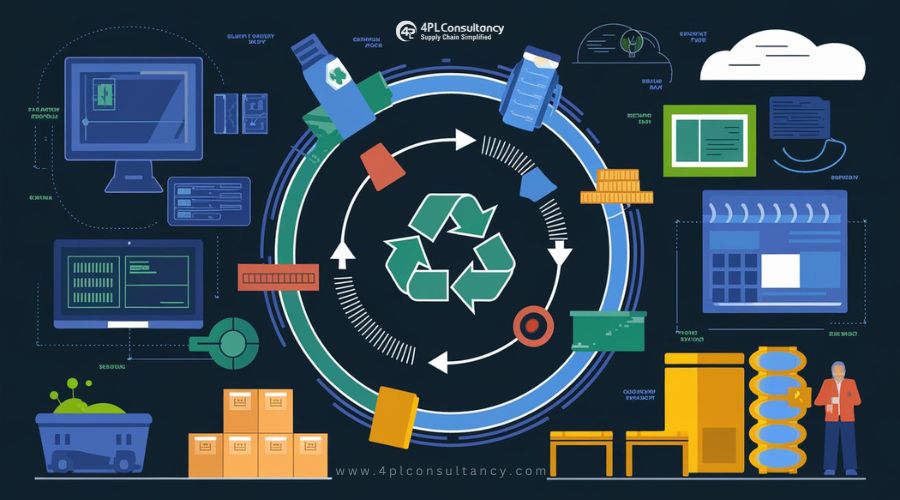Blog Details

Circular Economy in Supply Chain
Introduction
The concept of a circular economy is transforming the way supply chains operate. Unlike the traditional linear economy, which follows the "take, make, dispose" model, a circular economy emphasizes reusing, recycling, and regenerating resources. This shift is becoming increasingly critical as businesses strive to reduce their environmental impact and improve resource efficiency.
In the context of supply chain management, the circular economy is seen as a pathway to sustainability. Instead of discarding products after their lifecycle, circular supply chains encourage the reintegration of materials into the production process, forming a closed-loop system. This reduces waste, conserves resources, and minimizes the environmental footprint of businesses. With sustainability becoming a growing priority across industries, circular supply chain models are seen as a crucial driver of change.
Shifting from Linear to Circular Models in Supply Chain
In traditional supply chains, products are manufactured, used, and then discarded, generating significant amounts of waste. The circular supply chain, by contrast, seeks to minimize waste by reusing, refurbishing, or recycling materials. This shift requires rethinking how products are designed, produced, and consumed.
For example, in the automotive industry, companies are increasingly focusing on remanufacturing and refurbishing car parts instead of using new materials. This not only reduces waste but also cuts down on the resources required to manufacture new parts. Similarly, in the fashion industry, several brands have started recycling old garments to create new ones, which helps reduce the amount of waste sent to landfills.
The key difference between linear and circular supply chain models lies in the focus on resource regeneration. In a circular model, products and materials are continuously cycled back into the supply chain, thereby reducing the need for new raw materials. This transition from a linear to a circular economy is essential for achieving long-term sustainability in global supply chains.
Waste Reduction through Circular Supply Chains
One of the primary benefits of circular supply chains is the reduction of waste. By embracing circularity, businesses can reduce waste at every stage of the supply chain. For instance, remanufacturing involves repairing and refurbishing products to extend their lifecycle, which reduces the need for new materials.
In the electronics industry, companies are adopting circular practices by refurbishing old devices and reintroducing them to the market. By doing this, they not only reduce electronic waste but also decrease the demand for raw materials used in manufacturing new devices. Similarly, the automotive sector is focused on reusing parts like engines, reducing the environmental impact of production.
This approach aligns with the goals of a circular economy, which seeks to minimize waste and make better use of existing resources. By designing products with a longer lifecycle and encouraging practices like refurbishment and remanufacturing, businesses can significantly reduce their environmental impact.
Resource Optimization and Recycling in Supply Chains
Another critical component of the circular economy is resource optimization. In a circular supply chain, resources are used efficiently, and recycling becomes an integral part of the process. Businesses are now exploring ways to recycle materials to create new products or repurpose existing products, reducing the need for new raw materials and contributing to resource conservation.
For example, in the packaging industry, companies are focusing on using recycled materials to create new packaging solutions. This not only helps reduce the demand for virgin materials but also contributes to the reduction of plastic waste. Moreover, in sectors like consumer electronics, manufacturers are finding ways to recycle components from old devices, thus minimizing the extraction of finite resources like rare metals.
By embracing recycling and resource optimization, circular supply chains help conserve resources and reduce the strain on the environment. This not only benefits businesses by lowering costs but also aligns with the growing demand for sustainability from consumers and governments alike.
Sustainability in Circular Supply Chain Models
The adoption of circular economy principles is a key driver of sustainability in supply chains. By moving away from linear models and embracing circular practices, businesses can significantly reduce their carbon footprint, minimize resource depletion, and contribute to a greener future.
For example, by using recycled materials in production, companies can lower their carbon emissions associated with the extraction and processing of raw materials. Additionally, circular supply chains help reduce the environmental impact of transportation by optimizing logistics and minimizing waste. This contributes to the reduction of greenhouse gas emissions, a crucial factor in combating climate change.
As consumers become more environmentally conscious, businesses that adopt circular models are better positioned to meet the growing demand for sustainable products. Companies that prioritize sustainability not only reduce their environmental impact but also gain a competitive advantage by appealing to eco-conscious consumers.
Circular Economy and Consumer Demand
The rise of the eco-conscious consumer has accelerated the adoption of circular supply chains. Consumers are increasingly seeking products that are sustainably sourced and have a minimal environmental impact. As a result, businesses that adopt circular economy principles can tap into this growing market by offering environmentally friendly products.
For example, many fashion brands are responding to consumer demand by introducing circular practices such as clothing recycling programs and using recycled fabrics. Similarly, electronics companies are offering refurbished devices, which appeal to consumers who are both budget-conscious and environmentally aware.
This shift in consumer preferences underscores the importance of sustainability in modern supply chains. By adopting circular models, businesses can not only meet consumer demand but also differentiate themselves in a crowded marketplace.
Benefits of Circular Economy in Supply Chain
The circular economy offers several key benefits for businesses and the environment:
- Cost Savings and Efficiency: Circular supply chains can lead to significant cost savings by reducing material waste and reusing resources. This improves efficiency and lowers production costs, making businesses more competitive.
- Long-Term Value Creation: In addition to short-term savings, circular supply chains offer long-term value by creating sustainable business models. Companies that invest in circular practices can build stronger relationships with consumers, who are increasingly prioritizing sustainability in their purchasing decisions.
- Competitive Advantage: Businesses that adopt circular models gain a competitive edge by aligning with global trends toward sustainability and reducing their environmental impact. This helps them stand out in industries where consumers are increasingly focused on eco-friendly practices.
Challenges in Implementing Circular Economy in Supply Chain
Despite the clear benefits, implementing circular economy principles in supply chains presents several challenges:
- Reverse Logistics Management: Managing the return of products for reuse, recycling, or remanufacturing requires a robust reverse logistics system. This adds complexity to supply chain operations and may require significant investment in infrastructure.
- Infrastructure and Investment: Transitioning to a circular model often requires businesses to invest in new technologies and processes. These investments can be costly, particularly for smaller companies, and may be a barrier to widespread adoption.
- Collaboration Across the Supply Chain: Circular supply chains require collaboration between suppliers, manufacturers, and consumers. Ensuring that all parties are aligned in their sustainability goals can be a challenge, particularly in global supply chains.
How Technology Supports Circular Supply Chains
Technology plays a crucial role in enabling businesses to adopt circular supply chain models. Innovations such as blockchain, IoT, and AI are helping companies monitor and optimize resource use, reduce waste, and manage reverse logistics more effectively.
For example, blockchain technology can be used to track products throughout their lifecycle, providing transparency and ensuring that they are disposed of or recycled properly. IoT devices can help businesses monitor resource use in real time, allowing them to optimize operations and reduce waste. Similarly, AI-powered analytics can identify inefficiencies in supply chains and suggest ways to improve sustainability.
By leveraging technology, businesses can overcome some of the challenges associated with implementing circular models and ensure that their supply chains are as efficient and sustainable as possible.
Final Thoughts
The shift toward a circular economy is revolutionizing supply chain management. By adopting circular practices, businesses can reduce waste, optimize resource use, and create long-term value. As more companies embrace circular models, the future of supply chain management will become increasingly sustainable and resilient.
4PL Consultancy has a team of experts in Tariff classifications of wide variety of Product lines – Medical spares, Aerospace, Radiation Oncology machines & spares etc.





